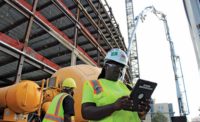The Devon-Sheridan study involves a series of electronically conductive strain gauges, some 17 in all, either affixed to the supplementary supports or to steel members embedded in their concrete footings. As trains cross the overpass, their weight simultaneously compresses the concrete, supplementary shoring and gauges. When the gauge shape changes, so does the device's conductive properties, which are measured and recorded by an onsite computer.
The computer, an off-the-shelf system common to the automobile industry, transmits the data it collects to the research institute via a continuous, secure Internet connection.
According to Kosnick, the system records two types of data. In addition to the "burst" data it logs when trains cross the viaduct, long-term data is recorded hourly to determine how the structure responds to load cycles and environmental changes.
Both data sets are required in order to assess the structure's performance under slowly and rapidly changing conditions.
"The objective is to assist the CTA in better managing its assets," says Marron. "Perhaps repair work scheduled to occur in two years can be postponed for 10 years."






Post a comment to this article
Report Abusive Comment